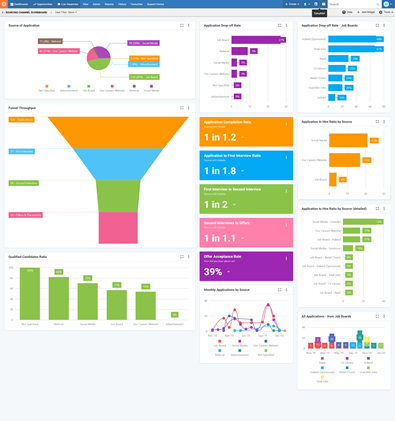Transitioning from Spreadsheets to an ATS - A Quick Guide
As recruitment practices continually evolve, it is important to keep pace with the latest tools in candidate management and talent attraction. Moving from manual tracking systems such as spreadsheets to an advanced Applicant Tracking System (ATS) is the easiest way to modernise and streamline your entire hiring process. But many recruiters are still unsure about how to make the leap and may be put off by the potential cost or the complexity of changing. Fortunately, there are plenty of resources available to aid the transition and ensure it is as smooth as possible.
tools in candidate management and talent attraction. Moving from manual tracking systems such as spreadsheets to an advanced Applicant Tracking System (ATS) is the easiest way to modernise and streamline your entire hiring process. But many recruiters are still unsure about how to make the leap and may be put off by the potential cost or the complexity of changing. Fortunately, there are plenty of resources available to aid the transition and ensure it is as smooth as possible.
Why Are Spreadsheets Still Used for Recruiting?
With recruitment software such as Applicant Tracking Systems being a relatively recent addition to the world of hiring talent, many recruiters have used spreadsheets throughout the majority of their careers. Making the switch to a more streamlined system can be daunting for those who are used to their current processes and ways of working. Spreadsheets are easily accessible, come pre-installed on most computers, and provide structure to data. They are, however, not built for recruitment and lack many of the features to meet the hiring needs of an organisation and complexities around recruitment data analysis and compliance.
Making The Switch
In order to get the best experience with an Applicant Tracking System, there are a series of steps that need to be undertaken:
steps that need to be undertaken:
Step One: Decide What You Need From an ATS
Before you start shopping around for potential ATS providers, it's vital to determine what you're looking for in the software. Think about the issues you currently face with manual recruitment methods and how an ATS can help with
automating job posting, candidate sourcing, resume screening, automated email functions, candidate communication tracking, team collaboration and detailed recruitment analytics. Once you have a clear list of requirements, it will be easier to compare the benefits and drawbacks of different ATS software. Some questions to ask yourself include:
- What is the biggest drain of your time?
- How long does it take you to compile recruitment data?
- Can you accurately report on recruitment KPI's?
Step Two: Choose an ATS That Fits Your Hiring Needs For The Longer Term
When choosing an ATS, think about your immediate needs and what will serve you well for the longer term. Consider the size of your team and your recruitment workload. Ask potential vendors about their specific ATS functionality and how they can best meet your needs. Can they provide references from existing customers relevant to your organisation?
Step Three: Train Your Team
Whether your team is used to working with spreadsheets or has never used digital tracking systems before, providing full training is essential to help maximise the potential of any ATS. Some ATS providers offer hands-on training during implementation, while others focus on video guided tutorials. Provide the team training on how to use the software, including how to set up job openings, navigate through the candidate database, and customise the system to your needs. Involve your team in creating an implementation plan, setting goals, and generating expectations for the transition period.
Step Four: Choose How to Manage Your Data Migrations
Data migration is another key consideration when switching from spreadsheet-based tracking to an ATS. You can transfer data by manually copying candidate records across (not ideal), or by using a bespoke data migration transfer system. Some ATS companies may be able to provide their own migration solutions. Aim to clear out old candidate data, ensuring compliance with GDPR resgulations before the migration, to ensure there are no duplicates and records are as up-to-date as possible.
Step Five: Monitor Performance, Refine the Process, and Keep Up-to-Date
Once the ATS is fully implemented, make sure to track the performance of recruitment activities . You can look at metrics like the time-to-hire or funnel conversion rates, which will help identify the areas that need improvement in your recruitment process. Make sure to create relevant reports to help keep track of important data in the system and to use this data for future decision-making.
. You can look at metrics like the time-to-hire or funnel conversion rates, which will help identify the areas that need improvement in your recruitment process. Make sure to create relevant reports to help keep track of important data in the system and to use this data for future decision-making.
Switching from spreadsheets to an ATS can significantly enhance your recruitment process. By determining your requirements, finding the right system, training your team, managing your data migration, and monitoring results, your business will be primed and ready to accelerate its recruitment activities. As you refine your ATS to continually align to your business needs, you can offer better, more efficient recruitment experiences for both your hiring team and your candidates. So, if you're worried about making the switch to an ATS - don't be! With the right guidance and support, it's a valuable step towards maintaining your organisation's competitive edge.
Contact Eploy for Applicant Tracking Systems (ATS) Expertise
At Eploy, we offer a highly configurable Applicant Tracking System designed to help you attract, hire, and speed up the process of recruitment. Get in touch with our specialist team at Eploy to find out how we can help you meet your recruitment goals or schedule a personalised demo. No hard sell, no strings attached. Just some winning ideas to help you with your recruitment strategy.